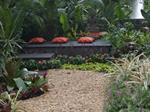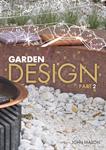Rock Your Garden With Coloured Pebbles And Gravel 
Coloured gravels were used in 18th century France to create designs on the surface of the ground – in effect partitioning the ground, often into geometric or symmetrical patterns. Red or brown gravel might have been used to mark out circles, rectangles or squares enclosed by low hedges, with white or cream gravel to create paths outside of the hedging. In this way, very simple gardens created a high impact – with patches of contrasting colour covering the ground, separated by low green hedging.

The same idea can be used today to create a distinctive garden feature. Pebbles are currently very trendy, with landscape designers using them as mulches, in mosaics and paving, and to surface paths and driveways. There are even pebble specialists that supply a large range of local and imported stones, in a range of different textures and colours.
What’s the Difference between Gravel and Pebbles?
Gravel is made from crushed rock. The stones have an angular, irregular shaped surface.
- Pebbles are smooth stones that have been naturally shaped by water, coming either from riverbeds or the seashore. Some pebbles are polished and tumbled before sale to improve their appearance in the landscape.
Minimising Maintenance
Weeds can be a problem. The most effective treatment is to eradicate weeds with a glyphosate herbicide before laying the pebbles. A weed mat can be of some use, but only on flat, bare ground. On sloping ground, the pebbles will wash down the slope, leaving an expanse of ugly matting.
A thick layer of pebbles will effectively choke out weeds. Any weeds that do appear will be fairly easy to pull out of the gravel but take care not to spread soil from the roots over the gravel surface, as this can encourage weed seeds to take root. Hand weed or spot spray any weeds as soon as they grow through the gravel – never let them set seed, otherwise you will end up with a major weed problem.
Also take care to prevent weeds blowing seeds across from nearby garden beds.
Thickness of Gravel or Pebble layers
The thickness of the layer depends on its intended use. For example:
- A gravel mulch will need to be around 40-60 mm deep.
- A mulch around pots around 10-20 mm deep.
- Gravel paths should be around 30-70 mm deep. You will have to top up gravel paths every now and then as chippings get removed through wear and tear, i.e. people’s shoes, rain, hosing and so on.
 Places for Pebbles
Places for PebblesSet in concrete (for cobble paving or mosaic walling)
- Between pavers, for contrasting texture and colour
- Inlaid in garden furniture, e.g. table tops
- As a pebble beach at the edge of a pool or water garden
- At the base of a pond, to hide the liner and provide anchorage for water plants
- On the surface of tub plants, for decoration and as a mulch
- As a mulch around plants to reduce weeds and for visual effect
- In a succulent garden, to provide a well-drained growing media and as a colour contrast with the plants
- In an artificial dry creek bed
- At the base of a waterfall to create a splashing noise
- In Oriental gardens, raked in patterns
Why not visit your local garden centre and be impressed at the phenomenal range of coloured, textured, crushed, polished, and otherwise treated pebbles and gravels. So, get out there and pebble or gravel your garden.
 VISIT OUR ACS ONLINE E BOOKSTORE
VISIT OUR ACS ONLINE E BOOKSTORE
- Quality ebooks written by our staff
- Wide range of Horticulture titles by John Mason, author of over 40 gardening books, garden magazine editor, nurseryman, landscaper and principal of ACS.
- Ebooks can be purchased online and downloaded straight away.
- Read on an ipad, computer, iphone, reader or similar device.
- New titles published every month –bookmark and revisit this site regularly
- Download sample pages for free, to see what each book is like.